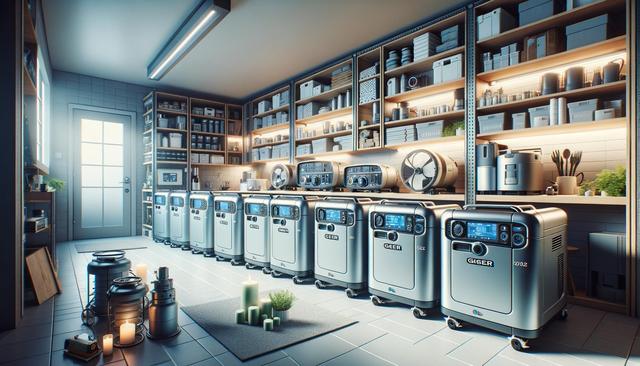Understanding the Types of Home Generators Available
The overall cost of a home generator set in 2025 will largely depend on the type of generator you choose. There are several types of home generators to consider, each with its own price range and installation requirements. The most common options include portable generators, inverter generators, and standby generators. Portable units are generally the most affordable, with prices expected to range from $500 to $2,000. These are suitable for temporary power during short outages but require manual setup and operation. Inverter generators, known for their quieter and more efficient operation, may cost between $1,000 and $3,000, depending on capacity and features. Standby generators, which are permanently installed and automatically activate during power outages, come with higher upfront costs. Prices for these systems in 2025 could range from $3,500 to over $10,000, not including installation.
When choosing a generator, homeowners should consider their specific power needs. For example, a small portable generator might be sufficient for charging devices and running a refrigerator, while a standby system can power an entire home, including heating and cooling systems. The type of generator you choose will directly influence both the purchase price and the ongoing maintenance costs.
Installation Costs and Professional Services
Beyond the price of the generator itself, installation costs are a significant part of the total expense. For portable and inverter generators, minimal setup is required, but for standby generators, professional installation is essential. This involves electrical wiring, fuel connections (typically natural gas or propane), and potentially obtaining permits. In 2025, installation costs for a standby generator could range from $2,000 to $5,000, depending on the complexity of the setup and local regulations.
It’s also important to factor in the cost of ancillary equipment and services, such as:
- Transfer switches (manual or automatic)
- Concrete pad installation for mounting the unit
- Fuel line extensions or modifications
- Electrical panel upgrades
Hiring a certified electrician or a licensed generator installer ensures the system complies with safety codes and operates reliably. Homeowners should obtain multiple quotes and ask for detailed estimates to understand exactly what’s included in the price.
Fuel Source and Operating Costs
The type of fuel a generator uses also affects the total cost of ownership. Most home generators run on gasoline, propane, or natural gas, with each fuel source having its pros and cons. Gasoline-powered generators are common in portable units but can be costly over time and have limited storage life. Propane offers cleaner combustion and longer shelf life, but may require large storage tanks. Natural gas is often preferred for standby systems since it’s connected directly to a utility line, offering continuous fuel supply with minimal maintenance.
Operating costs in 2025 will depend on fuel prices and how often the generator is used. For instance, during extended power outages, fuel consumption may significantly increase. Homeowners should consider:
- Average fuel consumption per hour (varies by model and load)
- Fuel storage and delivery logistics
- Expected hours of annual use
Maintenance costs also come into play. Generators require regular oil changes, filter replacements, and system inspections. Standby generators may also need periodic testing and servicing by professionals, adding to the long-term expenses.
Smart Features and Technology Upgrades
Modern home generators in 2025 are likely to include advanced features that enhance usability, safety, and efficiency. These smart enhancements may include remote monitoring, automatic diagnostics, mobile app controls, and load management systems. While these features add convenience, they can also increase the overall cost of the unit.
For homeowners who want to integrate their generator with a home automation system or solar energy setup, the initial investment may be higher. Additional components like smart load panels or battery backups can add anywhere from a few hundred to several thousand dollars to the total price. However, these upgrades could offer long-term benefits such as improved energy efficiency, more reliable performance, and easier maintenance tracking.
If you’re considering a generator with advanced technology, be sure to compare models based on:
- Monitoring and control options
- Compatibility with existing home systems
- Warranty and support services
These features not only enhance the user experience but may also contribute to the property’s value and appeal.
Budgeting and Financial Considerations
When planning for a home generator in 2025, it’s essential to look at the investment as a multi-year commitment. In addition to the upfront purchase and installation costs, homeowners should factor in ongoing maintenance, fuel expenses, insurance considerations, and potential financing options. Some generator providers may offer financing plans to spread the cost over several months or years, which can make the investment more manageable.
Here are a few tips to help budget effectively:
- Request itemized quotes from multiple vendors
- Check for local incentives or rebates for backup power systems
- Plan for annual maintenance costs ($200–$500 on average)
- Evaluate extended warranty options for long-term coverage
Moreover, investing in a generator can offer peace of mind during extreme weather events or grid instability. While the upfront costs may seem substantial, the value of uninterrupted power—especially for households with medical devices, remote work requirements, or climate-sensitive needs—can make it a worthwhile expense.
Conclusion: Planning Ahead for Reliable Power
As we head into 2025, the cost of a home generator set will depend on several factors, including the type of generator, installation complexity, fuel source, and added features. While prices can vary widely, understanding the components that influence cost will help homeowners make informed decisions that align with their budget and energy needs. Whether you’re seeking a basic portable unit or a fully automated standby system, planning well in advance and working with qualified professionals can ensure that your investment delivers both comfort and reliability when you need it most.


